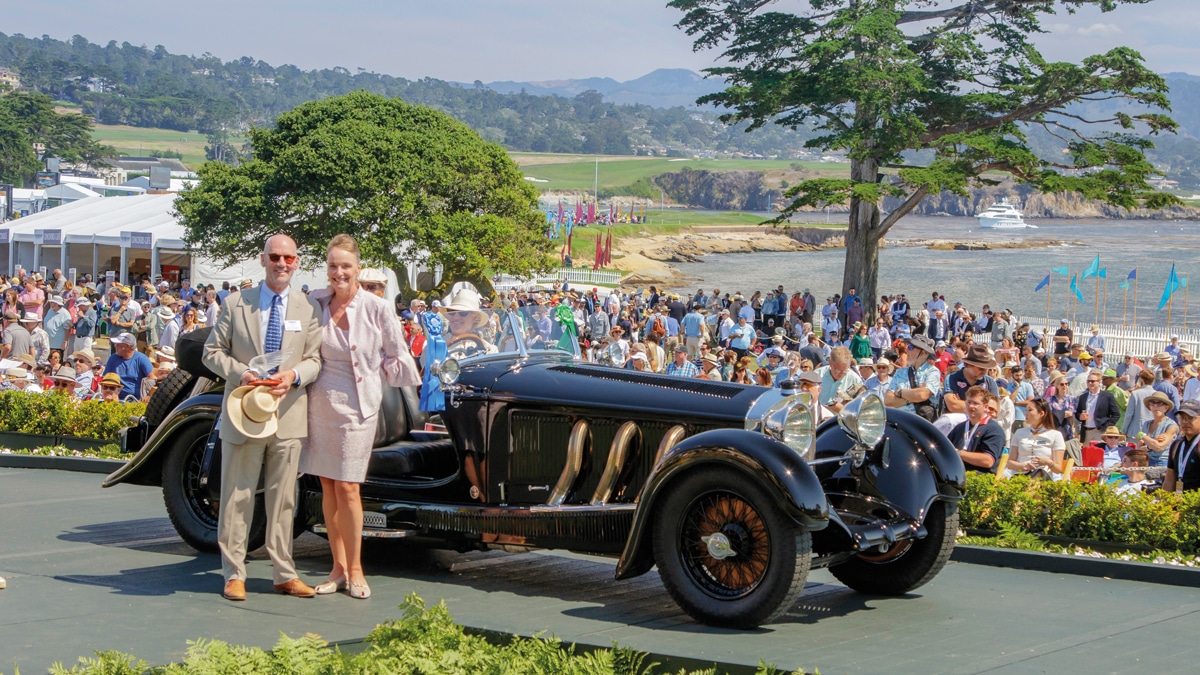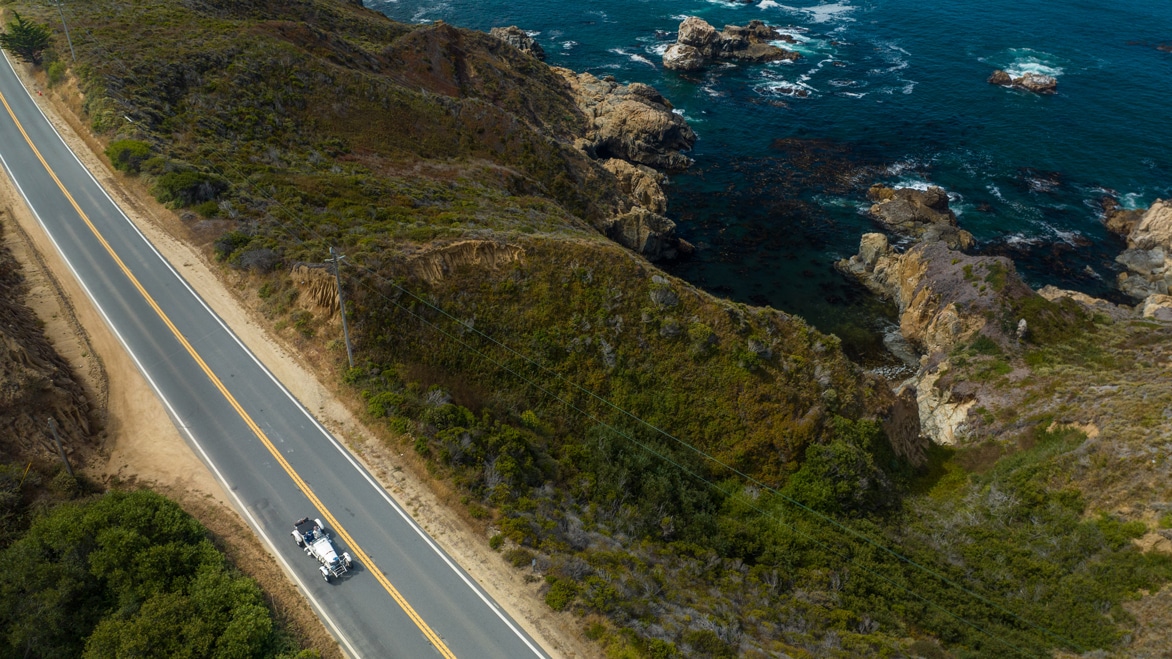The chairperson behind Pebble Beach Concours and her plans for change
Sandra Button on running the world-famous Pebble Beach Concours

Sandra Button with John Bentley, 2023’s recipient of the Lorin Tryon Trophy – presented to an enthusiast who has contributed significantly to the Concours
Kimball Studios/Pebble Beach Concours d’Elegance
The automobile world has always been a male-dominated one. So it’s partly refreshing and partly ironic that one of the greatest motoring events on the planet has run like clockwork for years thanks to the leadership of a woman.
Sandra Button had not long graduated from Washington State University in the early ’80s (with what proved to be a highly appropriate degree in business and hospitality administration) before she left her home town of Seattle and journeyed 1000 miles south to Pebble Beach to work in its golf and country club’s ‘special events’ department.
This meant organising everything from prize-giving dinners to dog shows – but the occasion that always excited her most was the annual classic car Concours d’Elegance, the now world-renowned happening that was conceived in 1950 as an aside to the Pebble Beach road races.
In 1991 – having worked on the show for five years – her passion for cars, her remarkable organisational ability and her exceptional people skills were fully recognised when she was appointed the first full-time executive director of the blue-chip event. Back then there were two co-chairmen, Jules ‘J’ Heumann and Lorin Tryon who, Button recalls, were “so great to work with. Really tough… but, because they had that complete commitment to excellence, we did great things.”
Button went on to be named co-chairman alongside Glenn Mounger and, since the latter’s retirement in 2005, has remained the sole chairperson of the event.
In the hierarchy of classic car leadership, it is undoubtedly one of the most important administrative positions there is. The fact that she loves cars has helped. Although her enthusiasm can’t be attributed to her family background – her father was an engineer with Boeing and her mother was a horticulturist – Button was drawn to cars from an early age.
The first car she drove was a 1965 Ford Mustang given by her father in the late 1970s, after which she bought a now highly collectible Datsun Fairlady which she used for a daily commute for five years prior to relocating to Monterey.
Since then, Button’s car collection has grown – not least as a result of Pebble Beach bringing her together with husband Martin Button, who runs the high-end classic car transport and logistics company Cosdel. Between them the couple own around 30 classics ranging from ‘brass-era’ machines, including the only surviving Lenawee (celebrating its 120th birthday) to a 1955 Cadillac Eldorado convertible, a 1937 Jaguar SS 100, a 1972 Ferrari 365 GTC and a 1928 OM. Appropriately, there’s also a 1951 Mercury Monterey in the stable.
The commitment to running the Pebble Beach Concours might not leave much time to enjoy the cars, but it doesn’t entirely prevent Button from driving them when time allows – as well as taking part in rallies and events on home soil, she has also competed in the Mille Miglia (in the OM) and, in 2006, she completed Louis Vuitton’s celebrated Boheme Run from Budapest to Prague via Vienna in the SS 100.
“More than anything else, the sound is always a big factor in a car for me,” she says.
That appreciation of a rorty exhaust note has not, however, precluded the admission of electric cars onto the Pebble Beach lawns. Indeed, one of Button’s main aims as chairperson is to maintain the relevance of the event. To that end, she works hard to increase its breadth without diminishing its carefully curated nature, which permits 175 cars to be displayed on the lawns, greens and fairways outside the golf club’s Lodge.
But, with concours traditionally being held to celebrate ‘old’ cars and the number of models fitting that description growing, deciding what to add and what to lose isn’t easy.
“A few weeks ago it occurred to me that in 1973 Lorin Tryon and Jules ‘J’ Heumann established an ongoing class for Ferrari, a relatively young marque,” explains Button. “To put that into context, Rolls-Royce and Bentley had ruled the Pebble Beach Concours for most of the prior two decades, often comprising two, three or even as many as five classes. The only other marque with an ongoing class of its own was Duesenberg – an American classic added by Lorin and J in their inaugural year. Even that had signalled a change. But I was struck by how forward-thinking it was to add Ferrari.”
She admits that it’s far from easy to gauge the ‘proper’ pace of change and that she struggles to be sure whether the event is moving too fast or too slowly towards the future. But evolution is certainly happening. “The past few decades have witnessed more breadth in the types of cars we showcase – from hot rods to microcars, along with more competition cars and preservation gems,” Button says.
The mix of cars has also shifted gradually from a predominance of pre-war creations to a nearly equal number of postwar designs. But until recently, with few exceptions, most postwar cars in the competition pre-dated the 1970s.
“Last year the classes for Porsche, Lamborghini and McLaren pushed well past this creation date – and this year all the GT race cars are from the mid- to late-1990s, and our Wedge class extends from the 1950s to 2017,” explains Button.
The two latter categories were inspired by the younger members of the selection committee, around a third of which are at or below the age of 50 – so outside of the baby boomer generation that witnessed the arrival of the original classic car phenomenon. Button says she and the advisory board are also working hard to include a more youthful contingent among the judging panel, while being careful to maintain the experience and expertise for which the concours is renowned.
And, while the Pebble Beach Concours is widely considered to be the sine qua non of global classic car shows, the organisers have not been afraid to look to other events in search of ways of maintaining the momentum.
“It’s important to observe how others are forging new paths in the collector car world,” says Button. “We’re looking, for example, at the Velocity Invitational just north of us at the Sonoma Raceway – where family is much of the focus – and at the wonderful Oberoi Concours d’Elegance in India, where they dared to host a class for cars of the masses.
“Personally, I can’t wait to see where our advisers, our selection committee members, our entrants and judges and, above all, our devoted enthusiasts and supporters decide to lead us in the future. As an event steeped in tradition, we have perhaps moved just a bit too gingerly at times. Thinking of Lorin and J, I feel emboldened to accelerate the pace.”

